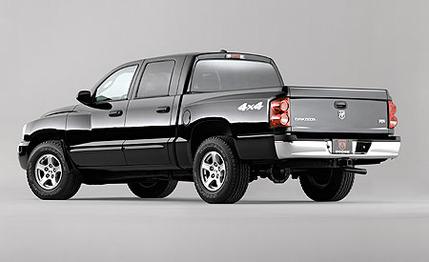 First Drive Review
First Drive Review
Considering that just about every horse in the Chrysler stable has been gifted with a Hemi engine option-the Magnum wagon, the 300 sedan, the Ram pickup, the Durango sport-ute, and the new Jeep Grand Cherokee-we asked David McDonald, Dakota program manager, if the Dakota were to be so blessed.
He tells us the Hemi's width would necessitate changes to the frame and upper-control-arm mounting points, resulting in additional development that wouldn't be cost-effective. Too bad, because we expected that Chrysler's magic motor would fit in the big engine bay.
The three engine choices, none of which has the word Hemi embossed on it, are a 210-hp, 3.7-liter V-6 and two 4.7-liter V-8s-a 230-hp version and a high-output 250-hp job. The 3.7-liter and lesser-output 4.7-liter engines are carried over; the high-output 4.7 is new and relies on a higher compression ratio, different valve springs, and a hotter camshaft for the increased output.
Dodge tells us that sales of the regular-cab model were dwindling, so the new truck comes only as a Club Cab or Quad Cab (two-plus-two or four-door, respectively) in three trim levels: ST, SLT, and new-for-'05 Laramie. Base prices range from $19,210 for a two-wheel-drive ST Club Cab to $29,324 for a four-wheel-drive Laramie Quad Cab. Figure on a price in the mid-20s for a sensibly equipped version.
In the previous model cycle, the Dakota was produced first, and then the Durango SUV followed on the same chassis. This time the order is switched. The Durango redesign expanded its dimensions. The Dakota, already larger than all the compact pickups and closing in on the full-sizers, couldn't grow further and now uses a revised platform with some sharing from the Durango.
The front and rear track are increased as much as 1.5 inches, but the wheelbase, width, and height all stay nearly identical. A stretch in length of 3.7 inches is the largest change, providing added crush space to meet stricter, upcoming crash standards. The new trucks all ride on the same 131.3-inch wheelbase (a 0.3-inch increase) and share the same overall length; the difference in cab configuration is accomplished by shrinking the bed from 78.0 inches on the Club Cab to 64.0 inches on the Quad Cab.
Being creatures of habit, the designers wanted a familiar Dodge face on the new Dakota. They experimented using identical Durango sheetmetal from the B-pillar forward but didn't like the result. Even so, the Dakota and Durango front ends are essentially look-alikes, and we couldn't distinguish which one was in our rear view when driving around during the press introduction in Nashville, Tennessee.
The lines and features-including sheetmetal, headlights, and taillights-are much sharper and more geometric, giving the truck the latest look of its big brothers, the Ram and the Durango. The designers have also reduced the glass-to-body ratio (think of an Intrepid versus a 2004 300), describing this as a "cocoon feeling of safety."
From the driver's seat you'll recognize a lot of Durango influence, from the identical instrument panel, steering wheel, and radio to the similarly edgy dash and center stack.
Improved refinement and reduced cabin noise were goals, which drove many changes. The front-door glass is 20 percent thicker, the dash and floor materials also are thicker, and the exhaust is routed through a 30-percent-larger muffler and two resonators.
The foundation is a welded steel frame with fully boxed hydroformed and roll-formed frame rails that, we were told, is eight times as stiff in torsion and twice as stiff in bending as the previous Dakota frame. A new independent coil-over shock-absorber front suspension works with a retuned multi-leaf-spring solid axle at the rear.
The new truck felt as if it had soft spring rates and delivered a ride that is much more carlike. This soft ride and smooth, linear steering are reminiscent of the Durango changeover. However, the new truck does feel somewhat disconnected when transitioning quickly from left to right.
A new Getrag six-speed manual replaces a five-speed and comes standard with the 3.7- and base 4.7-liter engines but is not available with the high-output 4.7. For the two-pedal folks, the V-6 gets a carry-over four-speed automatic with slightly different first- and second-gear ratios, and the V-8s get the five-speed unchanged from the '04 Dakota.
Since 2001, Dakotas have had optional part-time or full-time electronically controlled four-wheel drive, and these continue to be offered on the new model. Both systems have four-wheel-drive-locked high and low modes. The full-time system splits torque 48 percent to the front and 52 percent to the rear.
Towing capacity is increased to a maximum of 7150 pounds, up from 6500. This is much higher than that of compact trucks and is actually in full-size territory; the Toyota Tundra's max is 7100 pounds.
The brakes are discs in front and drums in back (the all-disc option has been canned). Rear-wheel ABS is standard; four-wheel modulation costs extra. Still not offered is traction or stability control, but Dodge hinted that these may come later in the model cycle.
With improved ride and handling and towing capacity, and the only available V-8 in the class, the Dakota should be a winner-Hemi or not.